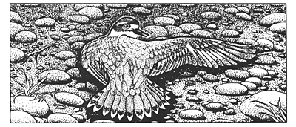Distraction Displays |
|||
|---|---|---|---|
|
Some
nesting birds make themselves as conspicuous as possible
when approached by a predator. Rather than attempting to
cover their nests, eggs, or young, these birds deliberately
attract the attention of the intruder, usually behaving in
an exaggerated manner. Although they may occasionally show
mild aggression by, for example, rapidly opening and closing
the bill, more often they feign an injury, exhaustion, or
illness to divert the predator from the nest or the
young. Broken-wing displays are most easily provoked and most realistic in shorebirds, waterfowl, and other species with ground nests. The displays typically involve |
||
|
spreading and dragging of a wing or tail,
while slowly fluttering away from the nest or young, and may
include calling or flashing of brightly contrasting
feathers. Some displays give the
impression of a running small mammal. For instance, in the
"rodent-run" display of the tundra-nesting Purple Sandpiper,
the bird drags its wings (creating the illusion of a second
pair of legs), erects its feathers (providing some
resemblance to fur), and "squeals" while it dodges between
imaginary barriers. There is little doubt that effectively leading a predator away from the nest would be strongly favored by natural selection, but how these stylized antics evolved remains controversial among behaviorists. Some conclude that distraction displays are a product of the conflicting desires of the parent to approach the predator aggressively, to return to the nest, and to retreat. Others suggest that they evolved directly as a predator defense, with more stylized sequences found in species that have had longer association with heavy predation. In either case, fear is a prerequisite; tame birds cannot be induced to perform distraction displays. Similarly, distraction displays may be reduced or eliminated from the behavioral repertoire through habituation to repeated nondamaging intrusions by predators (or experimenters). The most conspicuous and risky distraction displays occur when parental investment is greatest. Since the timing of maximum parental investment differs between altricial and precocial species, so too does the point in the breeding cycle when the adults give their most daring displays. Experimenters have measured, for example, how close to the nest an intruder can approach before a distraction display is elicited and how far from the nest the parent moves before performing. In altricial birds distraction displays are generally most conspicuous and, therefore, most risky to the parent just before the young fledge. At that point, parental investment is at its peak and the opportunity for renesting may already have been lost. For precocial birds, displays are most conspicuous and risky just at hatching, when the adults have made their maximum investment in the young. After that point, as the importance of parental care gradually declines, so do the displays. |
|||
| SEE:
Visual Displays;
Precocial and Altricial Young;
Mobbing;
Duck Displays;
Shorebird Communication;
Gulls Are Attracted to Their Predators;
Parental Care. Copyright ® 1988 by Paul R. Ehrlich, David S. Dobkin, and Darryl Wheye. |
|||
